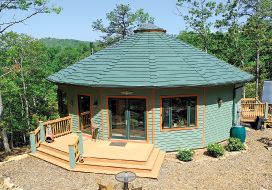The Inside Scoop on Residential Efficiency Policies
By Matt Grimley

Jim and Edrianna Stilwell used a federal energy tax credit to help them install a system that heats their home’s water using solar energy. Photo by Jim Stilwell.
Jim and Edrianna Stilwells’ home in Fairview, N.C., is immersed in nature. It sits at 3,500 feet and offers nearly 360 degrees of mountainous views.
It was designed to be energy efficient, and with lessening their carbon footprint in mind, the Stilwells decided to add a solar thermal system to their home.
A solar thermal collector was mounted outside to provide hot water to the home’s radiant floor heating, in addition to hot water for everyday use.
Jim Stilwell says that the system gave them a more efficient home, allowing them to pay about $40 a month for their winter electric bills and $300 a year for their backup propane heating system.
“[The solar water heating system] makes a lot of sense for someone who’s going to be in their home for a while,” he says. Looking ahead, he says that the next step for the home will be solar photovoltaic panels.
In installing the solar water heater, the Stilwells took advantage of the solar investment tax credit, one of a few federal energy tax credits. It allowed them to take 30 percent of the system’s cost, including labor and installation, and put it back into their wallets. Do you find yourself wanting to save on electricity and create a comfier home? Check out these energy efficiency policies for residential users. To see more state and federal energy efficiency policies, go to energy.gov/savings or dsireusa.org.
Energy-efficient Mortgage
The Goals: Finance the cost of energy-efficiency improvements into a new mortgage
Who Benefits: Any property owner who qualifies for a home loan
How It Works: A lender will issue you a mortgage based on the value of your home plus the projected cost of efficiency improvements. Because your home will be more energy efficient, you will save on utility costs and be able to devote more income to the monthly mortgage payment.
Where It Happens: Anywhere, through the Federal Housing Association. Check with local lenders to find who is FHA-approved.
More Info: Be sure to get a Home Energy Rating Systems report done before. Go to hud.gov for more information.
Property Assessed Clean Energy Financing
The Goals: Finance the cost of energy-efficiency improvements by providing upfront capital that is paid back through property taxes.
Who Benefits: Whoever pays the taxes on the residence, be it a home or a condominium
How It Works: In areas with PACE legislation, municipal governments offer bonds to investors. From the sale of the bonds, the local government offers a loan to consumers for energy efficiency retrofits. The loans are repaid over a specific term on the property tax bill. The loan is also attached to the property instead of the person.
Where It Happens: Anywhere with PACE legislation in place
More Info: In 2010, PACE financing through secondary mortgage entities Fannie Mae and Freddie Mac was blocked, suspending many residential programs. Check out pacenow.org to see if your state offers PACE financing.
Energy Efficiency Tax Credit
The Goals: Provide tax credits to individuals who make energy efficiency improvements on their homes.
Who Benefits: Taxpayers qualify and are allowed to take an aggregate amount of credit, up to $500.
How It Works: You can get tax credits for the purchase of a range of energy-efficient appliances and improvements, including biomass stoves, insulation, and windows and doors.
Where It Happens: Anywhere (as long as you pay your taxes)
More Info: These tax credits expire at the end of 2013. Check out energystar.gov for more information.
Weatherization Assistance Program
The Goals: Provide low-income families with free weatherization services
Who Benefits: As many as 20 to 30 million U.S. families are eligible for this free service, though requirements vary from state to state.
How It Works: Every state has a different WAP. You must first contact a local agency and apply to see if your family qualifies. If so, you get an energy consultation at your residence. If everything is good to go, workers will come and complete the project in a day or two.
Where It Happens:Every state
More Info: Go to www1.eere.energy.gov/wip/wap.html to see what programs your state offers.
Related Articles
Latest News

Leave a comment
Your email address will not be published. Required fields are marked *





Leave a Comment